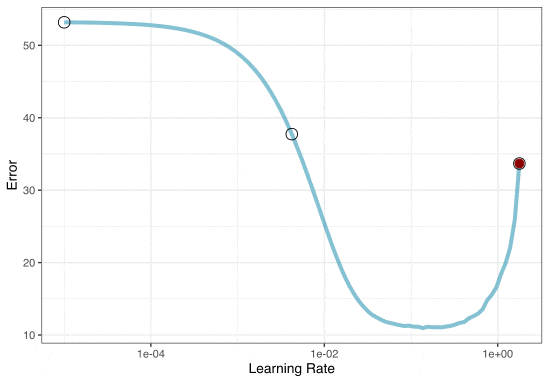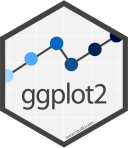2 - Tuning Hyperparameters
Advanced tidymodels
Previously - Setup ![]()
Previously - Data Usage ![]()
Previously - Feature engineering ![]()
![]()
library(textrecipes)
hash_rec <-
recipe(avg_price_per_room ~ ., data = hotel_tr) %>%
step_YeoJohnson(lead_time) %>%
# Defaults to 32 signed indicator columns
step_dummy_hash(agent) %>%
step_dummy_hash(company) %>%
# Regular indicators for the others
step_dummy(all_nominal_predictors()) %>%
step_zv(all_predictors())Optimizing Models via Tuning Parameters
Tuning parameters
Some model or preprocessing parameters cannot be estimated directly from the data.
Some examples:
- Tree depth in decision trees
- Number of neighbors in a K-nearest neighbor model
Activation function in neural networks?
Sigmoidal functions, ReLu, etc.
Yes, it is a tuning parameter. ✅
Number of feature hashing columns to generate?
Yes, it is a tuning parameter. ✅
Bayesian priors for model parameters?
Hmmmm, probably not. These are based on prior belief. ❌
Covariance/correlation matrix structure in mixed models?
Yes, but it is unlikely to affect performance.
It will impact inference though. 🤔
Is the random seed a tuning parameter?
Nope. It is not. ❌
Optimize tuning parameters
- Try different values and measure their performance.
- Find good values for these parameters.
- Once the value(s) of the parameter(s) are determined, a model can be finalized by fitting the model to the entire training set.
Tagging parameters for tuning ![]()
With tidymodels, you can mark the parameters that you want to optimize with a value of tune().
The function itself just returns… itself:
For example…
Optimizing the hash features ![]()
![]()
![]()
Our new recipe is:
We will be using a tree-based model in a minute.
- The other categorical predictors are left as-is.
- That’s why there is no
step_dummy().
Boosted Trees
These are popular ensemble methods that build a sequence of tree models.
Each tree uses the results of the previous tree to better predict samples, especially those that have been poorly predicted.
Each tree in the ensemble is saved and new samples are predicted using a weighted average of the votes of each tree in the ensemble.
We’ll focus on the popular lightgbm implementation.
Boosted Tree Tuning Parameters
Some possible parameters:
mtry: The number of predictors randomly sampled at each split (in \([1, ncol(x)]\) or \((0, 1]\)).trees: The number of trees (\([1, \infty]\), but usually up to thousands)min_n: The number of samples needed to further split (\([1, n]\)).learn_rate: The rate that each tree adapts from previous iterations (\((0, \infty]\), usual maximum is 0.1).stop_iter: The number of iterations of boosting where no improvement was shown before stopping (\([1, trees]\))
Boosted Tree Tuning Parameters
TBH it is usually not difficult to optimize these models.
Often, there are multiple candidate tuning parameter combinations that have very good results.
To demonstrate simple concepts, we’ll look at optimizing the number of trees in the ensemble (between 1 and 100) and the learning rate (\(10^{-5}\) to \(10^{-1}\)).
Boosted Tree Tuning Parameters ![]()
![]()
![]()
We’ll need to load the bonsai package. This has the information needed to use lightgbm
Optimize tuning parameters
The main two strategies for optimization are:
Grid search 💠 which tests a pre-defined set of candidate values
Iterative search 🌀 which suggests/estimates new values of candidate parameters to evaluate
Grid search
A small grid of points trying to minimize the error via learning rate:
Grid search
In reality we would probably sample the space more densely:
Iterative Search
We could start with a few points and search the space:

Grid Search
Parameters
The tidymodels framework provides pre-defined information on tuning parameters (such as their type, range, transformations, etc).
The
extract_parameter_set_dials()function extracts these tuning parameters and the info.
Grids
Create your grid manually or automatically.
The
grid_*()functions can make a grid.
Create a grid ![]()
![]()
lgbm_wflow %>%
extract_parameter_set_dials()
#> Collection of 4 parameters for tuning
#>
#> identifier type object
#> trees trees nparam[+]
#> learn_rate learn_rate nparam[+]
#> agent hash num_terms nparam[+]
#> company hash num_terms nparam[+]
# Individual functions:
trees()
#> # Trees (quantitative)
#> Range: [1, 2000]
learn_rate()
#> Learning Rate (quantitative)
#> Transformer: log-10 [1e-100, Inf]
#> Range (transformed scale): [-10, -1]A parameter set can be updated (e.g. to change the ranges).
Create a grid ![]()
![]()
set.seed(12)
grid <-
lgbm_wflow %>%
extract_parameter_set_dials() %>%
grid_latin_hypercube(size = 25)
grid
#> # A tibble: 25 × 4
#> trees learn_rate `agent hash` `company hash`
#> <int> <dbl> <int> <int>
#> 1 1629 0.00000440 524 1454
#> 2 1746 0.0000000751 1009 2865
#> 3 53 0.0000180 2313 367
#> 4 442 0.000000445 347 460
#> 5 1413 0.0000000208 3232 553
#> 6 1488 0.0000578 3692 639
#> 7 906 0.000385 602 332
#> 8 1884 0.00000000101 1127 567
#> 9 1812 0.0239 961 1183
#> 10 393 0.000000117 487 1783
#> # ℹ 15 more rows- A space-filling design tends to perform better than random grids.
- Space-filling designs are also usually more efficient than regular grids.
Your turn

Create a grid for our tunable workflow.
Try creating a regular grid.
03:00
Create a regular grid ![]()
![]()
set.seed(12)
grid <-
lgbm_wflow %>%
extract_parameter_set_dials() %>%
grid_regular(levels = 4)
grid
#> # A tibble: 256 × 4
#> trees learn_rate `agent hash` `company hash`
#> <int> <dbl> <int> <int>
#> 1 1 0.0000000001 256 256
#> 2 667 0.0000000001 256 256
#> 3 1333 0.0000000001 256 256
#> 4 2000 0.0000000001 256 256
#> 5 1 0.0000001 256 256
#> 6 667 0.0000001 256 256
#> 7 1333 0.0000001 256 256
#> 8 2000 0.0000001 256 256
#> 9 1 0.0001 256 256
#> 10 667 0.0001 256 256
#> # ℹ 246 more rowsYour turn

What advantage would a regular grid have?
Update parameter ranges ![]()
![]()
lgbm_param <-
lgbm_wflow %>%
extract_parameter_set_dials() %>%
update(trees = trees(c(1L, 100L)),
learn_rate = learn_rate(c(-5, -1)))
set.seed(712)
grid <-
lgbm_param %>%
grid_latin_hypercube(size = 25)
grid
#> # A tibble: 25 × 4
#> trees learn_rate `agent hash` `company hash`
#> <int> <dbl> <int> <int>
#> 1 75 0.000312 2991 1250
#> 2 4 0.0000337 899 3088
#> 3 15 0.0295 520 1578
#> 4 8 0.0997 1256 3592
#> 5 80 0.000622 419 258
#> 6 70 0.000474 2499 1089
#> 7 35 0.000165 287 2376
#> 8 64 0.00137 389 359
#> 9 58 0.0000250 616 881
#> 10 84 0.0639 2311 2635
#> # ℹ 15 more rowsThe results ![]()
![]()
Note that the learning rates are uniform on the log-10 scale.
Use the tune_*() functions to tune models
Choosing tuning parameters ![]()
![]()
![]()
![]()
![]()
Let’s take our previous model and tune more parameters:
lgbm_spec <-
boost_tree(trees = tune(), learn_rate = tune(), min_n = tune()) %>%
set_mode("regression") %>%
set_engine("lightgbm")
lgbm_wflow <- workflow(hash_rec, lgbm_spec)
# Update the feature hash ranges (log-2 units)
lgbm_param <-
lgbm_wflow %>%
extract_parameter_set_dials() %>%
update(`agent hash` = num_hash(c(3, 8)),
`company hash` = num_hash(c(3, 8)))Grid Search ![]()
![]()
![]()
Grid Search ![]()
![]()
![]()
lgbm_res
#> # Tuning results
#> # 10-fold cross-validation using stratification
#> # A tibble: 10 × 5
#> splits id .metrics .notes .predictions
#> <list> <chr> <list> <list> <list>
#> 1 <split [3372/377]> Fold01 <tibble [50 × 9]> <tibble [0 × 3]> <tibble [9,425 × 9]>
#> 2 <split [3373/376]> Fold02 <tibble [50 × 9]> <tibble [0 × 3]> <tibble [9,400 × 9]>
#> 3 <split [3373/376]> Fold03 <tibble [50 × 9]> <tibble [0 × 3]> <tibble [9,400 × 9]>
#> 4 <split [3373/376]> Fold04 <tibble [50 × 9]> <tibble [0 × 3]> <tibble [9,400 × 9]>
#> 5 <split [3373/376]> Fold05 <tibble [50 × 9]> <tibble [0 × 3]> <tibble [9,400 × 9]>
#> 6 <split [3374/375]> Fold06 <tibble [50 × 9]> <tibble [0 × 3]> <tibble [9,375 × 9]>
#> 7 <split [3375/374]> Fold07 <tibble [50 × 9]> <tibble [0 × 3]> <tibble [9,350 × 9]>
#> 8 <split [3376/373]> Fold08 <tibble [50 × 9]> <tibble [0 × 3]> <tibble [9,325 × 9]>
#> 9 <split [3376/373]> Fold09 <tibble [50 × 9]> <tibble [0 × 3]> <tibble [9,325 × 9]>
#> 10 <split [3376/373]> Fold10 <tibble [50 × 9]> <tibble [0 × 3]> <tibble [9,325 × 9]>Grid results ![]()
Tuning results ![]()
collect_metrics(lgbm_res)
#> # A tibble: 50 × 11
#> trees min_n learn_rate `agent hash` `company hash` .metric .estimator mean n std_err .config
#> <int> <int> <dbl> <int> <int> <chr> <chr> <dbl> <int> <dbl> <chr>
#> 1 298 19 4.15e- 9 222 36 mae standard 53.2 10 0.427 Preprocessor01_Model1
#> 2 298 19 4.15e- 9 222 36 rsq standard 0.811 10 0.00785 Preprocessor01_Model1
#> 3 1394 5 5.82e- 6 28 21 mae standard 52.9 10 0.424 Preprocessor02_Model1
#> 4 1394 5 5.82e- 6 28 21 rsq standard 0.810 10 0.00857 Preprocessor02_Model1
#> 5 774 12 4.41e- 2 27 95 mae standard 10.5 10 0.175 Preprocessor03_Model1
#> 6 774 12 4.41e- 2 27 95 rsq standard 0.939 10 0.00381 Preprocessor03_Model1
#> 7 1342 7 6.84e-10 71 17 mae standard 53.2 10 0.427 Preprocessor04_Model1
#> 8 1342 7 6.84e-10 71 17 rsq standard 0.810 10 0.00903 Preprocessor04_Model1
#> 9 669 39 8.62e- 7 141 145 mae standard 53.2 10 0.426 Preprocessor05_Model1
#> 10 669 39 8.62e- 7 141 145 rsq standard 0.808 10 0.00661 Preprocessor05_Model1
#> # ℹ 40 more rowsTuning results ![]()
collect_metrics(lgbm_res, summarize = FALSE)
#> # A tibble: 500 × 10
#> id trees min_n learn_rate `agent hash` `company hash` .metric .estimator .estimate .config
#> <chr> <int> <int> <dbl> <int> <int> <chr> <chr> <dbl> <chr>
#> 1 Fold01 298 19 0.00000000415 222 36 mae standard 51.8 Preprocessor01_Model1
#> 2 Fold01 298 19 0.00000000415 222 36 rsq standard 0.834 Preprocessor01_Model1
#> 3 Fold02 298 19 0.00000000415 222 36 mae standard 52.1 Preprocessor01_Model1
#> 4 Fold02 298 19 0.00000000415 222 36 rsq standard 0.801 Preprocessor01_Model1
#> 5 Fold03 298 19 0.00000000415 222 36 mae standard 52.2 Preprocessor01_Model1
#> 6 Fold03 298 19 0.00000000415 222 36 rsq standard 0.784 Preprocessor01_Model1
#> 7 Fold04 298 19 0.00000000415 222 36 mae standard 51.7 Preprocessor01_Model1
#> 8 Fold04 298 19 0.00000000415 222 36 rsq standard 0.828 Preprocessor01_Model1
#> 9 Fold05 298 19 0.00000000415 222 36 mae standard 55.2 Preprocessor01_Model1
#> 10 Fold05 298 19 0.00000000415 222 36 rsq standard 0.850 Preprocessor01_Model1
#> # ℹ 490 more rowsChoose a parameter combination ![]()
show_best(lgbm_res, metric = "rsq")
#> # A tibble: 5 × 11
#> trees min_n learn_rate `agent hash` `company hash` .metric .estimator mean n std_err .config
#> <int> <int> <dbl> <int> <int> <chr> <chr> <dbl> <int> <dbl> <chr>
#> 1 1890 10 0.0159 115 174 rsq standard 0.940 10 0.00369 Preprocessor12_Model1
#> 2 774 12 0.0441 27 95 rsq standard 0.939 10 0.00381 Preprocessor03_Model1
#> 3 1638 36 0.0409 15 120 rsq standard 0.938 10 0.00346 Preprocessor16_Model1
#> 4 963 23 0.00556 157 13 rsq standard 0.930 10 0.00358 Preprocessor06_Model1
#> 5 590 5 0.00320 85 73 rsq standard 0.905 10 0.00505 Preprocessor24_Model1Choose a parameter combination ![]()
Create your own tibble for final parameters or use one of the tune::select_*() functions:
Checking Calibration ![]()
![]()
Running in parallel
Grid search, combined with resampling, requires fitting a lot of models!
These models don’t depend on one another and can be run in parallel.
We can use a parallel backend to do this:
Running in parallel
Speed-ups are fairly linear up to the number of physical cores (10 here).
Early stopping for boosted trees
We have directly optimized the number of trees as a tuning parameter.
Instead we could
- Set the number of trees to a single large number.
- Stop adding trees when performance gets worse.
This is known as “early stopping” and there is a parameter for that: stop_iter.
Early stopping has a potential to decrease the tuning time.
Your turn

Set trees = 2000 and tune the stop_iter parameter.
10:00










